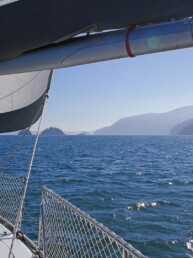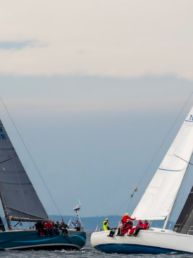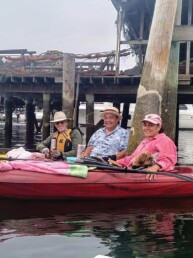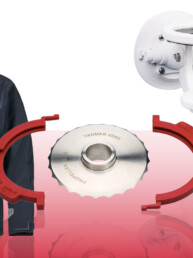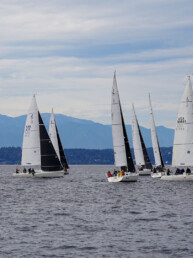Influential Coaches & the High School Sailing Boom
From the February issue of 48° North
On a misty Saturday afternoon, I sit with one of the local island families in the Orcas Island High School gym watching their daughter in the basketball game against Sultan High, another small school that traveled hours to be here. While the Orcas girls are leading the game by a solid 20 point margin, I’m more interested in the blue and white felt banners hanging up on the gym wall—especially the one that says NWISA High School Sailing (Northwest Interscholastic Sailing Association), with years listed below.
The other child in the family with whom I was watching the game had been part of the sailing team, and in 2017 they brought home the banner that says NWISA Team Race District Champs. His mother looks at the court and the banner, and tells me that when she realized her son wasn’t going to be interested in traditional sports like this, encouraging him to sail seemed like the perfect alternative.

High school sailing is deeply important to another Orcas Islander, Burke Thomas. Thomas has been one of the most influential leaders in youth sailing around the Pacific Northwest. Central to the development of Orcas Island’s youth and high school programs, he cites many reasons for his appreciation of high school sailing: “It’s co-ed, it’s affordable, it attracts a lot of different personality types, and you don’t have to be the jock type to be good at it. It requires more than that.” In a sport like sailing, schools the size of Orcas have a chance to compete against AAA high schools, and win. “When you can tell the community that the team is going to a nationals event in Florida, it’s a really big deal.” said Thomas.
Despite being an avid sailor in his youth, Thomas describes his coaching career as almost accidental. He grew up sailing on Lake Washington beginning when he was four-years-old, and moved up to crewing for his brother and skippering in junior sailing programs in Cozy Cove when he was just six. In fifth grade, with help from his older brother Craig, Thomas put together a Smith Brothers El Toro, which he raced on Greenlake and the NW circuit. Thomas moved on to the Seattle Laser Fleet in the 1970s. He credits his brother and Dick Rose with being “great mentors of the sport.” After sailing all through high school and college, Thomas reduced the intensity of his involvement—joining the occasional keel boat race—around 1981 when he married his wife of the past 38 years, Barbara.
In 2001 while he was devotedly raising his family and running his construction business on Orcas, someone on the island heard that he used to race sailboats and asked Thomas if he’d be willing to assist with part-time coaching of the new Orcas Island High School Sailing Team. Soon after his induction as a volunteer coach, the lead coach was called up for military duty, leaving Thomas with a full program to care for. After being away from the sport of racing for almost 20 years, he said that coming back to the water felt very familiar. It was a place to go to forget whatever worries he had back on shore. “Being on the water took the stress away and saved my life.” He saw it as a way for him to give back to the island community that had welcomed him in, and to pay forward the care and volunteerism displayed by those who had helped him learn to sail.
The exact origins of high school sailing in the Pacific Northwest are about as clear as the waters in Portage Bay. Seattle Yacht Club has records of junior sailing programs dating back to the 1930s. Inter-club youth racing—done in Flatties in those days—involved high schoolers. By the 1960s, Sea Scouts was running a racing program for high schoolers on Green Lake. Yet, according to a 2005 Seattle Times article that Thomas showed me, it wasn’t until 1996 that the district officially was formed in the way we understand it today, with school-affiliated teams racing on a structured circuit of regattas.
John DeMeyer, of Bainbridge, was the first District President. The small number of teams fluctuated, and when Thomas became NWISA President in 2005, there were only six active teams, including Bainbridge, Anacortes, Orcas, Friday Harbor, and North Kitsap. When Thomas stepped down as President in 2017, there were 56 active high school teams in the district, including his own.
When the district was founded, it was almost entirely volunteer run, and Thomas was part of a small group of smart, generous volunteer coaches. The idea of paid coaching is relatively new to Northwest sailing. Parents and sailing enthusiasts who wanted to bring their sport to a community’s youth grew teams out of their own pockets and hard work. Steve Orsini of Anacortes was one such parent and enthusiast. According to Orsisi, he joined with Gray and Carolyn Hawken, Fred Abelman, and Tom Glade, to start the sailing program in Anacortes— calling it the Anacortes Sailing Club. Orsini credits the Hawkens with providing much of the capital to get the team started and off the ground.
When asked why youth sailing was important, Orsini is enthusiastic. “Sailing is the original STEM course. Sailors have to sail in all kinds of conditions while striving for optimum performance. The sailboat race itself is like chess on the water involving strategic and tactical thinking,” and that, “When the dinghy leaves the dock, the skipper and crew are solely responsible for themselves. Sailing teaches self-reliance. Sailing is a life-long sport and skill.”
It was a similar pitch from Orsini back in 2014 that caught my attention and drew me into the sport. As a high school sailor, I felt fortunate to be part of something so unique that allowed me to travel around the Northwest and meet all types of interesting people. While the Northwest was one of the smaller districts, there was a sense of camaraderie between teams that was rare in other sports. Races were competitive and highly-charged at times, but you could see sailors from other teams helping each other load boats at the end of regattas, congratulating other competitors on good starts, and sharing advice between teams and coaches.
Burke Thomas recalled when another coach who has been central to the development of high school sailing in the region—longtime Bainbridge coach, Susan Kaseler—taught a Level One certification course on Orcas Island back in 2005. “She treated those 40 hours of instruction like the most important hours of her life and made my kids way better sailors.” The most intense race of my high school career was against one of Kaseler’s sailors, and at the end, both skipper and crew congratulated us on the finish.
Despite its recent and fairly humble beginnings, high school sailing is now booming around the Pacific Northwest. Boasting a growth rate of about 150% over the last five years, NWISA has become a force to be reckoned with in the world of youth sailing. “I know for sure that it’s going to become more competitive,” said Orsini. He also emphasized that it is now up to the coaches to maintain the community values that sailing offers in abundance.
Sailing, like any sport, comes down to the connections it builds. While it’s great to be able to go fast and win, there’s more to it than that. Crossing the line in first or thirty first doesn’t change a lot in the world, but having coaches and friends that you can rely on years after you’ve left the program can. On my high school team, we were not only taught which end of the finish line was favored after rounding the leeward mark, but we were also taught to say “thank you” to the race committee and “good race” to the boats around us when crossing that line.
The legacy of coaches like Thomas, Orsini, and Kaseler continues to expand in the fastest-growing youth sailing district in the country; and the sense of community they built is evident and central to the positive experience of future generations of high school sailors. While it can take hours of practice, focus, and chalk-talks to win, it takes almost nothing to return a bailer to a fellow teammate or to display good sportsmanship.
When sailors are supported by their coaches, parents, and each other, and feel comfortable to make mistakes, it allows for a more productive environment for growth. When I pointed out that I never saw Thomas raise his voice towards his sailors, he recalled developing this peaceful perspective through the experience of having his own children—yelling just doesn’t work.
The key to fast sailors is tiller time, and in order for kids to put that time in, they need to want to be there. Describing one of his jovial students who worked his way to the top of the fleet, Thomas said, “I didn’t know back in seventh or eighth grade that he was going to be a great sailor, but you could tell he was having a lot of fun, so I figured we’d start from there.”
After spending four years as an active participant in NWISA, I remember a few of my races and moments of personal growth, and I gained a deep appreciation for the sport of sailing. However, what I cherish most are the connections I took with me. As my sailing career has progressed, I’ve ended up needing those friendships and people, and always found them there for me—whether that’s needing a boat for my college team at a race 900 miles from home or needing advice on how to sail through choppy water at an unfamiliar venue. I hope that today’s NWISA sailors are continuing the tradition of care and community that will serve them long after their high school race days are over. If the ever-expanding pool of coaches follow in the footsteps of the coaching legends that brought NWISA high school sailing this far, the next generation will share the profoundly positive experience I had.
Julia Soes
Julia Soes is the head coach and program director of Sail Orcas and a member of the NWISA board. She races PHRF through the Anacortes and Orcas Island Yacht Clubs and is restoring the fastest Cal 20 the world has ever known, which only rates 300.

